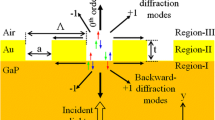Abstract
We discuss particular features of generation of surface plasmon polaritons in a metal–dielectric planar interface that is coupled to semiconductor quantum dots by near-field interactions. As a model of working medium for performing numerical experiment, we use a gold metal surface onto which a polyethylene terephthalate film containing CdSe semiconductor spherical quantum dot is deposited. The problem of optimizing the radius of a quantum dot and its distance to a metal surface is solved for achieving the maximum transfer efficiency of the quantum dot energy for the generation of surface plasmon polaritons. Dispersion effects of the surface wave generation rate associated with deviations of the radius of quantum dots and their distance to the metal surface from the corresponding average values are taken into account.





Similar content being viewed by others
REFERENCES
O. Keller, M. Xiao, and S. Bozhevolnyi, Surf. Sci. 280, 217 (1993). https://doi.org/10.1016/0039-6028(93)90370-Y
M. Xiao, S. Bozhevolnyi, and O. Keller, Appl. Phys. A 62, 115 (1996). https://doi.org/10.1007/BF01575709
R. R. Chance, A. Prock, and R. Silbey, Molecular Fluorescence and Energy Transfer near Metal Interfaces, Vol. 37 of Advances in Chemical Physics, Ed. by I. Pri-gogine and S. A. Rice (Wiley, New York, 1978). https://doi.org/10.1002/9780470142561.ch1
E. Kretschmann, Z. Phys. 241, 313 (1971). https://doi.org/10.1007/BF01395428
H. Raether, Surface Plasmons on Smooth and Rough Surfaces and on Gratings (Springer, Berlin, 1988). https://doi.org/10.1007/BFb0048317
E. Kretschmann, Opt. Commun. 6, 185 (1972).
D. Huang, M. Easter, G. Gumbs, A. A. Maradudin, S.‑Y. Lin, D. A. Cardimona, and X. Zhang, Opt. Express 22, 27576 (2014). https://doi.org/10.1364/OE.22.027576
C. Reinhardt, A. B. Evlyukhin, W. Cheng, T. Birr, A. Markov, B. Ung, M. Skorobogatiy, and B. N. Chichkov, J. Opt. Soc. Am. B 30, 2898 (2013). https://doi.org/10.1364/JOSAB.30.002898
T. Erdogan, J. Opt. Soc. Am. A 14, 1760 (1997). https://doi.org/10.1364/JOSAA.14.001760
J. Thomas, N. Jovanovic, R. G. Becker, G. D. Marshall, M. J. Withford, A. Tünnermann, S. Nolte, and M. Steel, Opt. Express 19, 325 (2011). https://doi.org/10.1364/OE.19.000325
J. Albert, L. Y. Shao, and C. Caucheteur, Laser Photon. Rev. 7, 83 (2013). https://doi.org/10.1002/lpor.201100039
Y. Y. Shevchenko and J. Albert, Opt. Lett. 32, 211 (2007). https://doi.org/10.1364/OL.32.000211
W. H. Weber and C. F. Eagen, Opt. Lett. 4, 236 (1979). https://doi.org/10.1364/OL.4.000236
W. L. Barnes, J. Mod. Opt. 45, 661 (1998). https://doi.org/10.1080/09500349808230614
N. E. Khokhlov, D. O. Ignatyeva, and V. I. Belotelov, Opt. Express 22, 28019 (2014). https://doi.org/10.1364/OE.22.028019
Ia. A. Babenko, I. A. Yugova, S. V. Poltavtsev, M. Salewski, I. A. Akimov, M. Kamp, S. Höfling, D. R. Yakovlev, and M. Bayer, Semiconductors 52, 531 (2018). https://doi.org/10.1134/S106378261804005X
A. I. Arzhanov, K. R. Karimullin, and A. V. Naumov, Bull. Lebedev Phys. Inst. 45, 91 (2018). https://doi.org/10.3103/S1068335618030077
A. V. Shesterikov, M. Yu. Gubin, S. N. Karpov, and A. V. Prokhorov, JETP Lett. 107, 435 (2018). https://doi.org/10.1134/S0021364018070081
I. V. Dzedolik and V. Pereskokov, J. Opt. Soc. Am. A 35, 1420 (2018). https://doi.org/10.1364/JOSAA.35.001420
I. V. Dzedolik, J. Opt. 16, 125002 (2014). https://doi.org/10.1088/2040-8978/16/12/125002
K. A. Magaryan, M. A. Mikhailov, K. R. Karimullin, M. V. Knyazev, I. Y. Eremchev, A. V. Naumov, I. A. Vasilieva, and G. V. Klimusheva, J. Lumin. 169, 799 (2016). https://doi.org/10.1016/j.jlumin.2015.08.064
T. Birr, U. Zywietz, T. Fischer, P. Chhantyal, A. B. Evlyukhin, B. N. Chichkov, and C. Reinhardt, Appl. Phys. B 122, 164 (2016). https://doi.org/10.1007/s00340-016-6437-5
A. O. Savostianov, I. Yu. Eremchev, A. A. Gorshelev, A. V. Naumov, and A. S. Starukhin, JETP Lett. 107, 406 (2018). https://doi.org/10.1134/S002136401807007X
M. Yu. Gubin, A. V. Shesterikov, M. G. Gladush, and A. V. Prokhorov, Bull. Russ. Acad. Sci.: Phys. 81, 1507 (2017). https://doi.org/10.3103/S1062873817120139
A. S. Kuraptsev and I. M. Sokolov, Phys. Rev. A 90, 012511 (2014). https://doi.org/10.1103/PhysRevA.90.012511
A. S. Kuraptsev and I. M. Sokolov, Laser Phys. 28, 085203 (2018). https://doi.org/10.1088/1555-6611/aac508
M. Yu. Gubin, A. V. Shesterikov, S. N. Karpov, and A. V. Prokhorov, Phys. Rev. B 97, 085431 (2018). https://doi.org/10.1103/PhysRevB.97.085431
ACKNOWLEDGMENTS
A.V. Prokhorov is grateful to Prof. A.B. Evlyukhin for useful discussions.
This work was supported by the Russian Foundation for Basic Research (project no. 16-02-01174 a) and was performed within the framework of state assignment 3.5531.2017/8.9 for Vladimir State University (project no. GB-1106/17).
Author information
Authors and Affiliations
Corresponding author
Additional information
XIII International Conference on Hole Burning, Single Molecule, and Related Spectroscopies: Science and Applications (HBSM-2018), August 6–12, 2018, Suzdal–Moscow, Russia.
Appendices
DERIVATION OF RELAXATION RATES b AND FREQUENCY ω OF DIPOLE OSCILLATIONS
Let us reduce Eq. (1) to a homogeneous differential equation and obtain relations for new relaxation rates and frequency shift. By substituting solutions (3) into Eq. (1), we obtain
After dividing this expression into \({{e}^{{\left( { - b/2 - i\omega } \right)t}}}\) and representing complex amplitude E0 in the algebraic form E0 = Re(E0) + iIm(E0), we obtain
We will separate the imaginary and real parts of the expression as follows:
and obtain the systems of the equations
By solving it simultaneously, we obtain
assuming that \({{\omega }^{2}} - \omega _{0}^{2}\) = \((\omega - {{\omega }_{0}})(\omega + {{\omega }_{0}})\) ≈ \(2{{\omega }_{0}}\Delta \omega \), where \(\Delta \omega = \omega - {{\omega }_{0}}\). Then, we obtain the following expression for frequency ω of dipole oscillations:
CALCULATION OF THE INTEGRAL FOR THE RATE OF SPP GENERATION BY THE CHANGE OF VARIABLES TECHNIQUE
Let us divide the improper integral of the second kind in (4) by a sum of integrals, taking into account that the integrand has an infinite discontinuity at the point u = 1:
Let us introduce u into the differential:
By making the change of variables u4 = x1 in (B1), we obtain
where
Then, we will make the following changes of variables in (B2): \({{t}_{1}}\) = \(\sqrt {1 - \sqrt {{{x}_{1}}} } \) (\({{x}_{1}}\) = \({{(1 - t_{1}^{2})}^{2}}\)) in the second term and \(t_{1}^{'}\) = \(\sqrt {\sqrt {{{x}_{1}}} - 1} \) (\({{x}_{1}}\) = \({{(t{{_{1}^{'}}^{2}} + 1)}^{2}}\)) in the third term. As a result, we obtain the following expressions:
where
Rights and permissions
About this article
Cite this article
Gubin, M.Y., Gladush, M.G. & Prokhorov, A.V. Configuration Resonance and Generation Rate of Surface Plasmon Polaritons Excited by Semiconductor Quantum Dots near a Metal Surface. Opt. Spectrosc. 126, 83–91 (2019). https://doi.org/10.1134/S0030400X19010065
Received:
Published:
Issue Date:
DOI: https://doi.org/10.1134/S0030400X19010065



